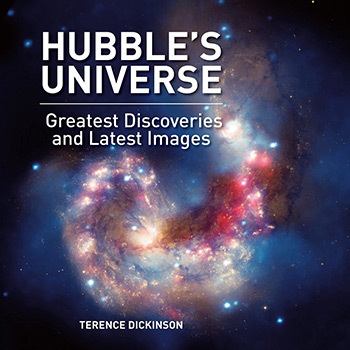Category: Non-Fiction
Reviewed by: Claire S. McMurray
From Ad Astra Winter 2015
Title: Hubble’s Universe: Greatest Discoveries and Latest Images
Author: Terence Dickinson
NSS Amazon link for this book
Format: Hardcover
Pages: 168
Publisher: Firefly Books
Date: September 2014
Retail Price: $29.95
ISBN: 978-1770854338
The universe is the ultimate art gallery, and this beautiful coffee-table book is a splendid guide to the visual treasures of space. If you love visual astronomy, or simply love beauty, Hubble’s Universe will keep you turning pages. Spectacular full-page, full-color photographs abound, with little area wasted on margins. Even the table of contents faces a dazzling full-page star cluster image. Frequent use of brief white text within black margins, so that the black of space has no obvious edge, brings the images into the reader’s environment.
Terence Dickinson is an award-winning Canadian astrophotographer and amateur astronomer who has written more than a dozen popular books on astronomy and astrophotography. It’s no surprise to find that the images in Hubble’s Universe are chosen with an artist’s eye.
In most chapters, the text serves primarily to orient the reader and explain the pictures. However, chapters 1-3 do provide an overview of astronomical observations, and explain why modern telescopes provide so much more information than even the best unaided eyesight. Even in these chapters, full-color astronomical photographs dominate.
The Hubble is a space telescope, so there are also pictures of the bus-sized instrument floating serenely above Earth, or undergoing its in-orbit service missions, along with a brief history of the Hubble Space Telescope’s design and construction. Brief nods are also given to Hubble’s orbital colleagues and collaborators, the Chandra X-ray Observatory and the Spitzer Space Telescope (which studies infra-red wavelengths). Some of the best images combine data from all three instruments.
This book is organized as a celebration of the Hubble’s window on celestial beauty, rather than a textbook on astronomy. For example Chapter 9, “Neighbor Worlds: the Planets,” fails to show Mercury or Venus. Mars, Jupiter, and Saturn are well depicted, but Uranus and Neptune appear only as three small pictures sharing a page with a crisp photo resolving the Pluto/Charon system, including the pinpoints of tiny Nix and Hydra. However, the best images of Pluto’s surface (before New Horizon’s 2015 flyby) are relegated to chapters 1 and 3. Neptune also appears in Chapter 3: “The Message of Starlight.”
Most of the rest of the book is devoted to wonderful images of star fields and nebulae. Hubble’s 270-hour exposure of one tiny patch of sky (often called the Deep Space Field) completely covers four pages; an additional one-page “map” of the same images in a smaller size shows how those pages fit together. A wider view, the “galaxy panorama,” covers another eight pages plus a two-page map. In fact, over a third of the book’s pages are devoted to full-page and double-page spreads of individual photographs.
In later chapters, written explanations and explanatory drawings share space with the still-prominent photographs. This is especially helpful in Chapter 7: “Hubble’s Invisible Universe,” and Chapter 10: “Hubble’s Strange Universe.” The two-page index, which includes the astronomical catalog numbers of many objects, will be useful to those who want to know more; as will the two pages of photo credits.
We dream of floating in space to see the universe without atmospheric distortion. Yet, since our eyes lack pupils able to match Hubble’s 7.9-foot wide aperture for gathering light, perhaps this book provides a better view.
© 2015 Claire S. McMurray
Claire Stephens McMurray is a member of the NSS conferences coordinating and chapters committees, and a former member (as Claire Stephens) of the NSS Board of Directors.
Please use the NSS Amazon Link for all your book and other purchases. It helps NSS and does not cost you a cent! Bookmark this link for ALL your Amazon shopping!




















